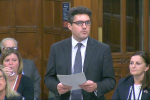Housing and planning is an important issue in the Bexhill and Battle constituency. I know that many local people have concerns, whether it be due to the type of development proposed in their area, or worries about the lack of affordable housing, particularly for young people.
The aspiration of homeownership is a fundamental value I support. It provides greater security and people become more rooted in their communities. Currently, too many people are being prevented from getting on the housing ladder and are being prevented from seeing the benefits of homeownership that their parents’ generation enjoyed.
My position has always been that we must build the right houses in the right places. This is especially true in our constituency which has a high proportion of land in protected zones, like the Area of Outstanding Natural Beauty (AONB). I want it to be easier to build much needed houses where it is right to do so, but see more protections for areas where more housing is not appropriate.
Underneath this article, you will find links to some of the work I have been involved with and suggestions I have put forward in this area.
Levelling Up and Regeneration Act
The Levelling Up and Regeneration Act which was introduced into Parliament on 11 May 2022. It received Royal Assent on 26 October 2023 and became law.
Housing targets
The Government’s standard method for assessing housing need provides a clear starting point for local planning authorities.
As part of its proposed changes to the National Planning Policy Framework, the Government consulted on making clear that these figures should be an advisory starting point, meaning that they will be a guide that is not mandatory. Local authorities, who are best placed to know their local areas best, will then work with their communities to determine how many homes can be built.
This will give them the ability to factor in constraints such as the Green Belt and the character of an area.
Infrastructure Levy
One of the most common reasons for opposing new housing developments that people share with me is related to the pressures on infrastructure. I agree that it is vital that we ensure new homes are accompanied by the infrastructure that new developments create the need for.
The creation of a new locally-set, non-negotiable Infrastructure Levy will help strengthen infrastructure delivery. Local leaders will be given the tools to bring forward more affordable housing and the transport links, schools and GP surgeries their communities need. They will be required to prepare infrastructure delivery strategies that will provide transparency to local communities about how levy proceeds are being spent.
The infrastructure levy, which will replace section 106 contributions for most developments, will prevent developers from negotiating down the amount they contribute to the community when they bring forward new projects.
Under the proposals, the amount developers will have to pay will be calculated once a project is complete, instead of at the stage the site is given planning permission. This will make sure that councils benefit from increases in land value, which can be significant for large developments that take years to complete.
Councils will also be given powers to set rates themselves, putting power in the hands of local leaders to deliver what their communities need.
The levy will also give communities more control over how this money is spent. A portion of the money will be passed directly to communities as a ‘neighbourhood share’ to fund their infrastructure priorities, while councils will be required to engage with communities and create a infrastructure delivery strategy.
Five-year housing land supply and presumption in favour of sustainable development
The Department for Levelling Up, Housing and Communities is proposing removing the requirement for local planning authorities to maintain a rolling five-year supply of deliverable land for housing where their local plan is up-to-date.
The reasoning behind this is to encourage local planning authorities to keep their local plans updated and address concerns about speculative development. Currently, buffers are built into the five-year housing land supply system as a contingency. To simplify the planning system, the Secretary of State is proposing removing these from national planning policy in the future. This would include removing the requirement for a 20 per cent buffer to be added for both plan making and decision making when a local planning authority delivers less than 85 per cent of the homes planned for.
These changes would mean that, for local authorities with up-to-date local plans, the presumption in favour of sustainable development will typically not apply in relation to issues affecting land supply. It is only right that the presumption in favour of sustainable development remains part of the planning system as a means of ensuring that development comes forward when up-to-date local plans are not in place.
Maintaining the primacy of local plans
Ensuring that local planning authorities have an up-to-date local is the best way to ensure that high-quality homes are delivered in the right places.
The Levelling Up and Regeneration Act is creating a genuinely plan-led system, with more weight given to local plans in planning decisions and measures to ensure they are delivered more quickly. It is my firm belief that the best way to deliver high-quality homes in the right places is by adopting local plans.
Many local plans take longer to design and adopt than they should and are often hard to digest. It is also the case that a lot of national policy is already replicated in local plans. I therefore support plans in the Levelling Up and Regeneration Act to set out policy which apply across all or many authorities at a national level, such as policies on Green Belt and protections for heritage assets.
This will help ensure that local plans can focus on issues that matter to local communities.
Sewage and waterways
- Water authorities as statutory consultees
In October 2022, I led a debate in Parliament on sewage pollution.
During the debate, I called for an end to developers being able to build new housing which is allowed to add to the 100,000+ miles of combined sewars and stated my belief that water authorities should be statutory consultees to planning applications. Effectively, this would mean that there would be no more housebuilding where the sewage situation is going to be made worse.
During Report Stage on the Levelling-up and Regeneration Bill in December last year, the Government announced that it would “consult on whether to make water companies statutory consultees” in the planning process. This means LPAs could be legally required to consult water companies before making a decision on planning applications for new developments.
I have sought more details from the Department for Levelling Up on this issue and have attached the response I received from the Housing Minister, Rachel Maclean. You can find this response here.
- Upgrade of wastewater treatment
Provisions included in the legislation will require water companies to upgrade wastewater treatment works in designated catchments by 1 April 2030.
It is estimated that this will lead to significant improvements – around a 69% reduction in phosphorus loads and around a 57% reduction in nitrogen loads in total from wastewater treatment works, although this will vary between individual catchments.
These upgrades will benefit existing homes, not just new homes, providing an effective approach to reducing wastewater nutrient pollution. This action will reduce a significant source of nutrient pollution to Habitats Sites, and builds on the wider measures outlined in the Plan for Water to transform and integrate our water system through more investment, tighter regulation, and more effective enforcement.
- Nutrient neutrality
In addition to wastewater upgrades, the Government laid amendments to the Bill and unveiled a wider package of environmental protections, which would have seen much needed housing being allowed to be built and the root cause of the nutrient problem can be tackled.
The House of Lords voted on the amendment on 13 September 2023. Ahead of the vote, I wrote in detail about what the Government's proposals meant which you can find here. Ultimately, though, the Lords decided to vote down the Government's amendment.








